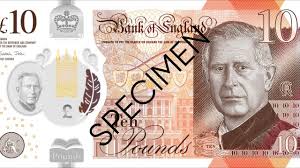By Tony O’Reilly-
For the first time in history, the portrait of King Charles III will appear on British banknotes, marking a significant moment in the country’s numismatic history. Starting from June 5, 2024, the Bank of England will issue notes featuring the new monarch’s image, replacing the long-standing portrait of Queen Elizabeth II.
This historic change comes as part of a gradual transition that reflects the nation’s evolving monarchy while maintaining a commitment to environmental and financial prudence.
The new banknotes will feature King Charles III’s portrait on the front, with the design of the reverse side remaining unchanged. This means that the £5 note will continue to honor Sir Winston Churchill, the £10 note will celebrate Jane Austen, the £20 note will depict JMW Turner, and the £50 note will feature Alan Turing.
The King’s image will also appear in cameo in the see-through security window, adding an additional layer of authenticity and security to the notes.
The Bank of England has confirmed that polymer banknotes bearing Queen Elizabeth II’s portrait will remain legal tender and will co-circulate with the new notes. This approach ensures a smooth transition and minimizes disruption to the public and businesses alike.
In line with guidance from the Royal Household, the Bank of England has adopted a phased approach to introducing the new banknotes. The primary objective is to minimize environmental impact and financial costs. New notes featuring King Charles III will be printed only to replace worn-out notes and to meet any increase in demand for cash. As a result, people will start to see the new banknotes in their wallets gradually, rather than all at once.
This careful approach underscores the Bank of England’s commitment to sustainability. By limiting the production of new notes and utilizing existing designs, the environmental footprint of the transition is significantly reduced. This method also aligns with broader efforts to promote responsible resource use and reduce waste.
The introduction of King Charles III’s portrait on banknotes is a momentous event, continuing a tradition of depicting reigning monarchs that dates back centuries. The first Bank of England note to feature a monarch was issued in 1960, featuring Queen Elizabeth II on the £1 note. Her portrait on British currency became a symbol of stability and continuity, seen and used daily by millions.
Queen Elizabeth II’s long reign saw numerous changes in currency, including the transition from paper to polymer notes, which began in 2016 with the introduction of the polymer £5 note. These polymer notes are more durable, secure, and environmentally friendly than their paper predecessors, and they feature advanced security features designed to prevent counterfeiting.
The shift to King Charles III’s portrait marks the end of an era and the beginning of a new chapter in British numismatic history. This transition is not just about changing faces on currency but also about reflecting the continuity and evolution of the British monarchy.
While the new banknotes featuring King Charles III are set to enter circulation, coins bearing his effigy have already been in use since December 2022. These coins were first introduced through post offices across the UK, allowing the public to familiarize themselves with the new royal portrait. The introduction of both notes and coins featuring King Charles III symbolizes the full integration of the new monarch into the daily lives of Britons.
The public’s response to the new banknotes is expected to be largely positive, given the historical significance and the careful planning behind their introduction. The Bank of England has




